by Ali Birston ~ March 22nd, 2013
As a marketing student passionate about sustainability, I could not have been more thrilled to dive into a course combining these two passions during my last term at UBC. Although initially I wasn’t quite sure what to expect, I can honestly say that my perspectives have been positively expanding since our very first lecture. It was in that lecture that we discussed the meaning and goals of both sustainability and marketing separately and then how and if they could successfully intersect. While I had always been aware of marketing sustainable products, I had never fully thought about marketing “sustainability” as a concept to change people’s behaviour. Right away, this was eye-opening as I realized that there are so many different ways that myself as a future marketer could create impact rather than just fuel consumption.
My knowledge, thoughts, and perspectives have continued to evolve throughout the term and now that we’re nearing the final couple of classes, here are some of my biggest takeaways:
- Don’t just be skeptical, be informed. Like a lot of people out there, I used to be a skeptic when it came to “green” claims and when I saw corporations that I didn’t trust trying to become “sustainable”. It is clear that sustainability is definitely a trend, however, it is one that I don’t think is going anywhere. Companies are now realizing this and rather than just jumping on the bandwagon they are sticking around for the ride. While my skepticism has not disappeared completely, I now know how much information there is out there on green alternatives and how much there is still left to absorb. There is no excuse for making poor choices. It may take a little more effort, a little more research, and often a couple more dollars, but to sustain our earth it is all worth it.
- We love instant gratification. But is it worth sacrificing our well-being and success in the long run? This is a question that as a business student I ask myself a lot. I believe that it is too often seen as a trade-off, however, I now challenge myself to think if it really has to be. I personally love living in the now and reaping the benefits, however, this course has certainly reinforced my belief in considering the future implications of present day decisions to ensure that we even have an environment to sustain our economy 100 years down the road.
- Businesses are trying to do good, but we as consumers must encourage and support them. Working directly with a company that has whole-heartedly embraced sustainability for our final project has shifted my perspectives to allow me to see how many businesses truly are driven to do good in the world. However, more importantly, they can only do good so long as we as consumers support them and as marketers we choose to work for mission driven companies that are pushing sustainability forward. We need to start putting our money where our values are in everyday decisions in order to show companies that sustainability really is the way of the future.
All in all, I could not be more thankful to have taken this course, not necessarily because it drastically changed my beliefs, but rather because it reinforced what I already knew to be true. Sustainability is more than just a fad, it’s the only way we’re going to ensure our long-term success as businesses, humans, ecosystems, and as a global community.
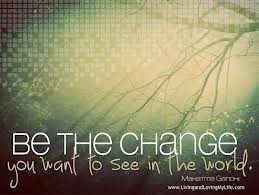
Filed under: Comm 486F | No Comments »
by Ali Birston ~ March 2nd, 2013
One of the biggest things that we as North Americans tend to take for granted is access to clean water. It seems so fundamental to our everyday lives, yet there are over 2.6 billion people that have little or no access to clean drinking water, most of whom live in underdeveloped parts of the world. Although we take it for granted, it is clear that water scarcity and quality is a big global issue, an issue thirsting for change, innovation, and new solutions.
One such sustainable innovation that I recently came across represents the perfect example, literally, of “sustainable marketing.” Believe it or not, it is a unique billboard that includes advanced water capturing and filtration systems to convert humidity in the air into clean drinking water for hundreds of families in Lima, Peru. This project was the result of a collaboration between the Lima University of Engineering and Technology and agency Mayo DraftDCB and has the capacity to produce up to 96 liters of potable water that gets stored in reserve tanks for locals to come collect.
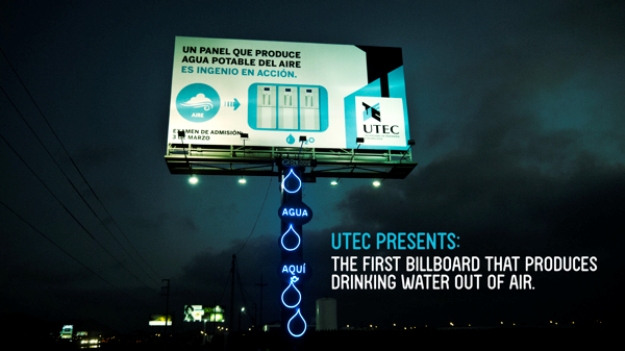
As a marketing student, this is certainly one of the coolest sustainable technology developments I’ve seen in a while. To take something like a traditional billboard which typically has no other purpose than to serve the needs of marketers, and to transform it into something that is solving a serious sustainability issue and serving the needs of hundreds of families is incredible to say the least.
Currently the billboard is not only generating water but also serving as an advertisement for the university creating a win-win solution. This concept certainly has great potential to be replicated in many other developing cities, and could be an excellent avenue for sustainable companies looking to market their products in the future. The costs may certainly be higher, but the exposure and impact would be the true long-term benefit of this new innovation.

Reference articles: Mayo DraftFCB created the generator, which gives residents of Lima in Peru clean drinking water, Engineers develop world’s first water producing billboard for Peru
Filed under: Comm 486F | 1 Comment »
by Ali Birston ~ February 17th, 2013
Valentines day. For most it is a time of love and romance. A time where “I love yous” are exchanged, chocolates are consumed and candles are lit. At its core it is about spreading love, however, in our age of consumerism this “love” is now being shown more and more with things. Teddy bears, jewelry, chocolate treats, and most of all flowers. We, women especially, have such high expectations of receiving, yet has anyone stopped to consider the impact of these novelty gifts on our planet?
After reading an article called “How Green Are Your Flowers?” it caused me to ponder this exact question, specifically with regards to the beautiful roses I recently received. I had never really considered where they came from or who worked to create the beautiful bouquets, never mind if they were grown in a sustainable manner.
 According to this article, if you buy a bouquet online or at a corner market (in the US), there is an 80% chance it is being imported from Columbia or Ecuador. So much for trying to purchase local. However, don’t fret, if you still want to ensure your flowers are ethical you can check to see if it carries a label certification from programs like Fair Trade USA, the Rainforest Alliance or the Florverde Sustainable Flowers brand. By buying these certified products, you can be assured that fair labor requirements are being met and that workers are provided with safe conditions. While this is certainly a step in the right direction, these programs only cover a small share of global flower production and still leave many issues of social and environmental sustainability unsolved.
According to this article, if you buy a bouquet online or at a corner market (in the US), there is an 80% chance it is being imported from Columbia or Ecuador. So much for trying to purchase local. However, don’t fret, if you still want to ensure your flowers are ethical you can check to see if it carries a label certification from programs like Fair Trade USA, the Rainforest Alliance or the Florverde Sustainable Flowers brand. By buying these certified products, you can be assured that fair labor requirements are being met and that workers are provided with safe conditions. While this is certainly a step in the right direction, these programs only cover a small share of global flower production and still leave many issues of social and environmental sustainability unsolved.
 So, while I hate to put a downer on Valentines Day, I think it is important to consider the impact of our everyday purchasing decisions, including those special occasions of the year. Are there other ways to show our love without fueling consumption and giving into the mass marketing brainwashing? One club right here at UBC had an innovative solution. Bring in paper from your recycling and they would create paper rose bouquets for your special someone. Just goes to show that maybe “green” and Valentines Day can in fact go hand in hand.
So, while I hate to put a downer on Valentines Day, I think it is important to consider the impact of our everyday purchasing decisions, including those special occasions of the year. Are there other ways to show our love without fueling consumption and giving into the mass marketing brainwashing? One club right here at UBC had an innovative solution. Bring in paper from your recycling and they would create paper rose bouquets for your special someone. Just goes to show that maybe “green” and Valentines Day can in fact go hand in hand.
Filed under: Comm 486F | No Comments »
by Ali Birston ~ February 8th, 2013
You don’t have to be ridiculous to be green.
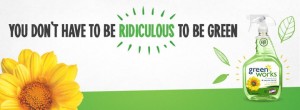
This is the tagline from the latest Clorox GreenWorks marketing campaign aimed at making eco-friendly people friendly again. This campaign comes shortly after some research by the company was conducted that found that women in particular are drawn to the “trendiness” of being green with more women saying they felt pressure to be green (39%) than skinny (29%). In addition, it was found that 73% of Americans would choose a green product from a mainstream brand over a product from a lesser-known green company, yet the biggest barrier is price. With this in mind, Clorox has now made it their mission to make green accessible and practical for a wide range of consumers.
Having recently done a case study on Clorox and their growing green portfolio of brands, I was initially impressed at their effort to try and make green mainstream and thought that co-branding Green Works with the Clorox brand name was a strategic move. However, judging from this campaign, that strategy may have taken a turn for the worse. Take a sneak peak, if you haven’t already, at the Green Housewives.

While I personally did not take offense to this campaign, I understand why there has been so much outcry from consumers via social media. Instead of making green accessible, they seem to be alienating their biggest base of consumers, women who are into sustainability. While I do think it’s okay to poke fun at how ridiculous being “green” has become, shouldn’t those people be the ones being rewarded not ridiculed for their behavior which is surely having a much greater positive impact that those who are just switching cleaning products?
References: Clorox Green Works: What were they thinking?, Clorox Mocks ‘Ridiculous Green’ Consumers
Filed under: Comm 486F | No Comments »
by Ali Birston ~ January 30th, 2013
When you think of the most common associations that come to mind when you think of the brand name McDonalds, I bet that sustainability is not high on the list. McDonalds has built its brand around providing value, quick service, and fun for the family, so why turn to sustainability now?
The pure volume of food McDonalds produces (to give a rough estimate there are over 33,000 stores around the world) on its own, presents a huge sustainability hurdle to overcome, never mind the fact that this volume is coming from some of the most unsustainable foods out there such as beef. However, that doesn’t seem to be stopping them from trying.
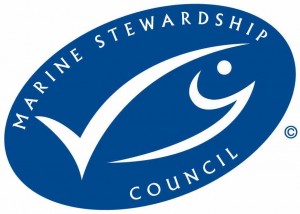 In addition to their recent efforts to reduce animal cruelty in their supply chain, they recently announced that they received the Marine Stewardship Council certification for their U.S. supply chain. This certification requires that McDonalds source fish from suppliers that follow strict standards for ecosystem impact, management, as well as health of fish stock. So for all you lovers of the Filet-O-Fish sandwhich, you can now celebrate the fact that your order will be made with wild-caught Alaska Pollock.
In addition to their recent efforts to reduce animal cruelty in their supply chain, they recently announced that they received the Marine Stewardship Council certification for their U.S. supply chain. This certification requires that McDonalds source fish from suppliers that follow strict standards for ecosystem impact, management, as well as health of fish stock. So for all you lovers of the Filet-O-Fish sandwhich, you can now celebrate the fact that your order will be made with wild-caught Alaska Pollock.
While this certification may seem like a small move for McDonalds, it could have huge effects across the industry since competitors are surely watching, taking note, and will hopefully follow suit. Therefore I do applaud their effort, although doubt it will make much of an impact to consumers. Changing perceptions of a brand that is so strongly associated with their core product offerings such as the Big Mac which are both unsustainable and unhealthy is incredibly tough. Their fish products are still such a small percentage of their overall business that unless they make more dramatic changes to increase the sustainability of their entire supply chain and their sourcing of beef then I don’t think they will be changing the minds of eco-conscious consumers any time soon.
Reference: Mcdonald’s now Serves Certifiably Sustainable Fish, But Does it Matter?
Filed under: Comm 486F | No Comments »
by Ali Birston ~ January 23rd, 2013
After reading a fellow classmate’s blog post about the underlying intentions of reusable shopping bags (“Green Selling, a Grocery Store’s best friend”) it got me thinking about the impact this new green trend is actually having on the environment. Considering how many times people forget their bags and how many extra bags people possess beyond what they need, is this actually making a difference or do people just do it for the status symbol?
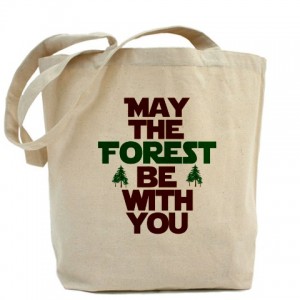 I completely agree with Morgan’s argument that green bags are one easy way a company can make themselves appear to be sustainable. It is so true that most consumers have one too many reusable bags at home, so why are people still buying them? And more importantly, why are manufacturers still producing them despite the fact that the production, transportation, and distribution of them cannot be all that sustainable.
I completely agree with Morgan’s argument that green bags are one easy way a company can make themselves appear to be sustainable. It is so true that most consumers have one too many reusable bags at home, so why are people still buying them? And more importantly, why are manufacturers still producing them despite the fact that the production, transportation, and distribution of them cannot be all that sustainable.
After doing some research of my own, I came across some more shocking news about these seemingly eco-friendly bags. They actually have the potential to kill you.
You’re probably wondering how on earth is that even possible? Well, the big problem, that probably will not come as a surprise to you, is that most people who re-use bags never bother to clean them. And, since only around a quarter of consumers use a separate bag for meat and veggies, who knows what sort of bacteria is being cross contaminated. Well, according to tests, coliform bacteria (mostly harmless) was found in 51% of the bags and E. coli (very risky) was found in 12% of the bags.
 Don’t fret, washing the bags reduces bacteria by 99.9%, however, as the writer of a recent Bloomberg article on this topic brings up, is it worth it to risk our lives to save a couple of seabirds choking to death on our plastic bags?
Don’t fret, washing the bags reduces bacteria by 99.9%, however, as the writer of a recent Bloomberg article on this topic brings up, is it worth it to risk our lives to save a couple of seabirds choking to death on our plastic bags?
In my opinion it really comes down to how much we as individuals are willing to sacrifice in the name of sustainability. And if it is something we strongly believe in, it is definitely worth understanding all the facts to make sure we are doing no harm to ourselves and to our mother earth.
Filed under: Comm 486F | No Comments »
by Ali Birston ~ January 17th, 2013
Packaging: you either love it, hate it, waste it, recycle it, or reuse it, but have you ever thought of turning it into a work of art? That is exactly what Dutch baby stroller manufacturer Joolz has decided to do. By combining just the right mix of innovation and cleverness, they are now trying to do their part to minimize their impact on the environment, and more specifically on consumer waste.
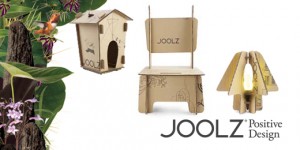 While recycling is always a good option, it doesn’t really add any value to consumers (well other than that warm feeling you get inside from doing something good.) However, Joolz is changing that by essentially giving a second life to their packaging, and more specifically their cardboard boxes. On every box there are printed directions to turn it into a brand new item which could be anything from a lampshade to a birdhouse, a picture frame or a chair, meaning that not only do you get to create something new, but also something that is useful too!
While recycling is always a good option, it doesn’t really add any value to consumers (well other than that warm feeling you get inside from doing something good.) However, Joolz is changing that by essentially giving a second life to their packaging, and more specifically their cardboard boxes. On every box there are printed directions to turn it into a brand new item which could be anything from a lampshade to a birdhouse, a picture frame or a chair, meaning that not only do you get to create something new, but also something that is useful too!
In my opinion this is quite a novel idea. One that may appear intriguing in advertisements, but may not actually be practical in real life. First of all, what if the item your box can be transformed into isn’t something you would use and second of all if the effort required to make the new product is too high, consumers may not be motivated to do it when throwing it in the trash is so much easier.
So while I appreciate the creativity behind it, before I see some real facts on how many moms are actually spending the time using the new item and most importantly how much waste is being diverted from landfills, I will not yet be a believer. On the flip-side I do think this should be an inspiration to manufacturers around the globe on how to find new, imaginative ways to reinvent tradition and design product packaging that helps rather than hurts our environment.
Reference: Cardboard packaging includes directions for turning it into something new
Filed under: Comm 486F | No Comments »
by Ali Birston ~ January 10th, 2013
As a consumer in today’s day and age where “green” is becoming mainstream and more and more companies are making claims about sustainability, it can almost seem overwhelming making purchasing decisions. Whether they are relatively significant investments or just a regular grocery shop, how do we really know if we’re making a difference by purchasing local ingredients or by choosing to drive a hybrid car? And beyond that, how can we track our purchases over time to reduce our impact?
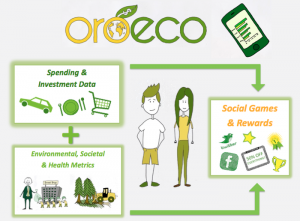 While buying the new iPhone 5 may have not been your most sustainable purchase decision, at least it will come in handy to help you download the new app called Oroeco. While it is currently in beta testing, this app is designed to “tackle climate change, one purchase at a time”. How you may ask? Oroeco automatically tracks spending (through Mint.com) and then visualizes the climate change impact (starting with GHG emissions) of each transaction. It then goes one step further by recommending tips for improvement, and by reminding you of personal goals you set for yourself. Last but not least, it incorporates a social dimension by allowing you to compare and compete with Facebook friends and earn “oro” points to unlock virtual prizes and real world rewards.
While buying the new iPhone 5 may have not been your most sustainable purchase decision, at least it will come in handy to help you download the new app called Oroeco. While it is currently in beta testing, this app is designed to “tackle climate change, one purchase at a time”. How you may ask? Oroeco automatically tracks spending (through Mint.com) and then visualizes the climate change impact (starting with GHG emissions) of each transaction. It then goes one step further by recommending tips for improvement, and by reminding you of personal goals you set for yourself. Last but not least, it incorporates a social dimension by allowing you to compare and compete with Facebook friends and earn “oro” points to unlock virtual prizes and real world rewards.
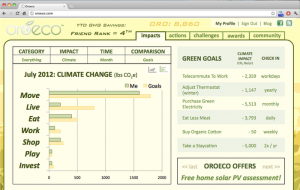
Although this app may not necessarily change behavior right away, by increasing awareness about the carbon footprint of our everyday purchases it is certainly a step in the right direction. Not only will this app hopefully encourage a shift from consumers, but also from brands as well who will need to respond accordingly. By putting our money where our mouths are, we are showing companies that we value truly sustainable products and that we, as individuals, can indeed lead the green revolution.
References: Sustainable, Ethical Decisions? There’s An App For That, Indiegogo – Oroeco
Filed under: Comm 486F | No Comments »
by Ali Birston ~ November 18th, 2012
Why only focus on conveying a message through your own social media profiles when you could be leveraging the social influence of your fans and followers to significantly amplify the effect?
It is now obvious that brand evangelists have enormous power to affect and potentially boost sales, however, the trouble is in determining who these key “influentials” are in the first place.
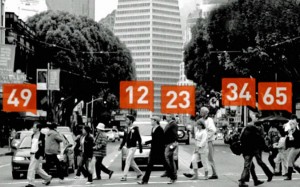 This is exactly the need that is being met in the online marketing realm through the use of social analytics such as Klout, a measure (between 1-100) of social influence based on a person, group or brand’s activity and audience on social networks. This tool has been hugely popular since it was launched in 2008, but is now being challenged by several startups such as Tellagence and Little bird who are differentiating their services by finding influencers in narrower categories and uncovering people who may have low Klout scores but whose social activity could actually lead to effects on sales.
This is exactly the need that is being met in the online marketing realm through the use of social analytics such as Klout, a measure (between 1-100) of social influence based on a person, group or brand’s activity and audience on social networks. This tool has been hugely popular since it was launched in 2008, but is now being challenged by several startups such as Tellagence and Little bird who are differentiating their services by finding influencers in narrower categories and uncovering people who may have low Klout scores but whose social activity could actually lead to effects on sales.
By processing over 12 billion data points per day, these new influence models claim to be more accurate, thus making them increasingly appealing to marketers. Yet, if the goal really is to impact the bottom line then we need to be more strategic about how we’re currently using social media as a tool to achieve real results. These results may not materialize overnight, however, by staying on top of analytics tools such as these, we are not only saving time, but investing smarter to target those who really matter.
Reference: Finding Social Media’s Most Influencial Influencers
Filed under: Comm 464 | No Comments »
by Ali Birston ~ November 11th, 2012
When it comes to incentives, nothing beats winning a $50,000,000 Lotto Max jackpot. When I stumbled across this particular post from Be Remarkable on my Facebook newsfeed I was struck with how simple, yet genius the idea was. Within seconds of seeing my friend had liked the post, I followed suit and made a comment in the hopes of sharing in the prize.
The concept was simple: purchase a lottery ticket and if it happened to be the winning ticket the money would be shared with fans who engaged with the photo. But most importantly, the call to action was strong and beyond easy for users: just like and comment on the photo and you could share in part of the $50 million jackpot.
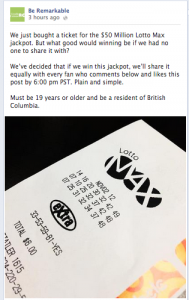
Sounds simple, but the results were pretty remarkable. Within a matter of three hours they had well over 6,000 likes, close to 4,000 comments and over 250 shares. Not only is that alone impressive, but what strikes me as the most strategic part of the campaign is how many people it has the potential to reach. I had never heard of Be Remarkable (a community for BC Credit Unions) before an old friend happened to like it and it appeared on my news feed, which I’m sure was the case among many diverse networks of people all across British Columbia and beyond.
It just go to show that overcoming the barrier to engagement on social media really comes down to appealing to consumers’ most basic desires. Generic calls to action may generate responses from a select few active “Creators”, however, in order to foster engagement within the broader community of social media “Spectators”, a good tactic is to ensure posts are simple, but with a clear incentive.
Although I never ended up getting a share in the jackpot, I can’t argue the fact that this was hugely beneficial for BC Credit Unions in terms of awareness and social media buzz. However, if the true aim of social media is to generate genuine engagement and develop meaningful relationships with their community of users, then this just seems like a cheap bribe.
Filed under: Comm 464 | No Comments »















